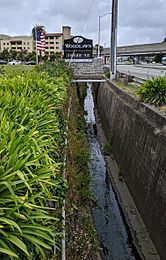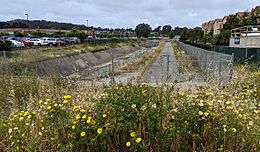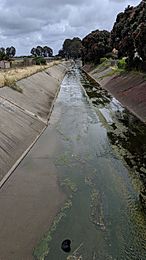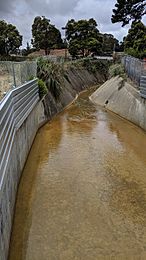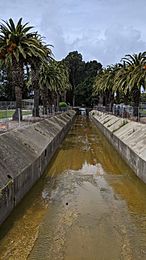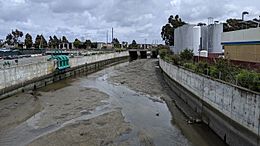Colma Creek facts for kids
Quick facts for kids Colma Creek |
|
|---|---|
| Country | United States |
| State | California |
| City | South San Francisco |
| Physical characteristics | |
| Main source | Northern San Bruno Mountain San Mateo County 37°40′27″N 122°27′29″W / 37.67417°N 122.45806°W |
| River mouth | San Francisco Bay (Pacific Ocean) San Mateo County 0 ft (0 m) 37°38′40″N 122°23′33″W / 37.64444°N 122.39250°W |

Colma Creek is a small waterway in California. It starts in the Crocker Hills, part of San Bruno Mountain State and County Park. Another small stream, April Brook, also adds water to the creek.
The creek flows southwest at first. Then, in Daly City, it makes a sharp turn. It then flows southeast through Daly City, Colma, and South San Francisco. Finally, it reaches the San Francisco Bay. The area where it meets the bay is between South San Francisco and the San Francisco International Airport.
Colma Creek has a smaller stream that flows into it. This stream is called Twelvemile Creek. It joins Colma Creek from the southwest in South San Francisco.
History of Colma Creek
Long ago, Colma Creek had a large wetland area at its mouth. This wetland was a very important resting spot. Many migratory waterfowl (birds that travel long distances) and other animals used it.
However, like many creeks in cities, Colma Creek has changed a lot. Parts of it are now surrounded by walls. These walls help control floods. Some parts of the creek have even been buried underground. Much of its large wetland area was filled in. This happened because of new buildings and developments.
Today, the lower parts of the creek have fewer native plants. This is because of the flood control projects. This change has reduced the natural home for animals. For example, the endangered Ridgway's rail bird has less habitat. Other species that rely on the creek also face challenges.
Restoring the Creek's Environment
The very beginning of the creek, called the headwaters, has many non-native trees. These include eucalyptus, cypress, and Himalayan blackberry plants. These plants are not from the area. They have taken over from native plants like dogwood and willow.
Sometimes, the creek can even dry up. This happens because the non-native plants use a lot of water. They lower the water level at the creek's source.
In 2005, a group called Shelterbelt Builders made a plan. Their goal was to help the creek return to its natural state. They planned to remove the plants that don't belong there. Then, they would plant native plants that grow near water.
Also, new wetlands were created in South San Francisco. This was done to make up for wetlands lost during floodwall construction. Experts hope the Ridgway's rail will return to these new wetlands. Other animals that lost their homes due to the flood control work might also come back.
Watercourse Gallery



